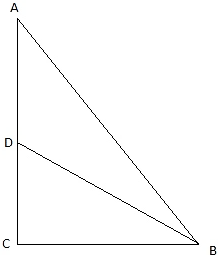A vertical tower stands on a horizontal plane and is surmounted by a vertical flagstaff of height 6 m. At a point on the plane, the angle of elevation of the bottom of the flagstaff is 30° and that of the top of the flagstaff is 60°. Find the height of the tower. [Use √3 = 1 .732.]

Let AD be the Flagstaff, 6m high and DC be the tower. B be the point on the plane from where the angles of elevation of the top(A) and bottom of the flagstaff(D) are 60° and 30° respectively. Join C and B. Then we get two triangles ABC and BCD with right angle at C. We are to find the height of the tower DC. Now, to summarize, we are given, AD = 6m, ∠ ABC = 60°, and ∠ DBC = 30°. To find DC we will first find BC from the triangle ABC and again from triangle BCD and equate the expression for BC in both the cases. Then we will solve for DC from the equation.
In ∆ABC,
![]()
or,
![]()
In ∆BCD,
![]()
or,
![]()
Equating the values of BC,
![]()
or,
![]()
or,
DC = 3m
Hence the height of the tower is 3m.